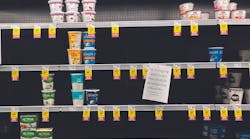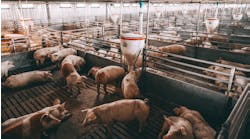Everyone knows the world’s supply chain is a mess. COVID, climate change and now war is destroying the carefully planned networks of suppliers, shippers, distributors and manufacturers. Ingredients from locust bean gum to stevia to wheat are in perilously short supply.
“In my 30-plus years in this business, I have not seen such an alignment of factors negatively impact the food supply chain – COVID, weather impacts on crops, and the geopolitical situation,” says Rick Williams, practice lead-operations & supply chain for JPG Resources. “All are concerned.”
The problems are impacting food production directly and indirectly, and solutions are proving elusive. Nevertheless, food processors are working through this.
“Everything is on the table right now to combat these challenges, including size changes, formulation changes and packaging changes,” says Jonathan Finch, senior director for client services-non-food at Daymon. “Whatever can be done to minimize the inflationary environment and keep production efficiency high.”
What’s going on?
Problems in the supply chain are nothing new – in a system that complex, it seems something is always going wrong. But what’s especially vexing about the current situation is the number of problems hitting at once.
COVID, of course, was the first blow. It quickly led to major labor problems, followed by devastating shipping problems.
One ingredient that felt the effects of COVID was the sweetener stevia, according to Nancy Hughes, president of Apura Ingredients. She says a combination of inadequate farm labor due to COVID and less-than-ideal yields resulted in a harvest of only 40,000 tons of dried stevia leaves in 2021, the lowest amount in six years. The situation has improved somewhat in 2022, but there is still inadequate raw product to meet demand.
“With the continued emphasis on sugar reduction, it will be challenging to meet the global market demand,” Hughes says. “We can see there will be shortages in 2022-2023, especially for the common stevia grades of RA97/RA80.”
But COVID’s effect, just as the pandemic itself, has been easing over the past six months.
“I don’t think we’re having the same level of problems, because the overriding factors are not there anymore,” says Ron Leibman, head of McCarter & English Transportation, Logistics & Supply Chain Management Practice. “There are still some issues because of shortages of trucks, and there are still delays in ports as the system cleans itself out, but it’s not close to what we saw before.”
Manufacturers that kept costs down by practicing just-in-time delivery of ingredients suffered the most because of COVID’s shipping disruptions, and many are adjusting to prevent that from happening again, Leibman says. Those companies are strategically managing their stock in order to keep enough on hand yet still control warehouse costs.
“The reality is we need to find the low cost for everyone, but in a middle ground that allows us some redundancy,” he says.
Another blow to ingredient supplies has been climate change. The effects of storms, droughts and fires are regional, but their combined impact is felt worldwide. For example, in April coffee futures were up 82% over the previous April, partially because of increasing temperatures in coffee-growing regions. And vegetable oil prices surged 4.2% in the month of January alone, according to the UN Food and Agriculture Organization, largely due to drought in parts of South America and typhoons in Malaysia.
Vanilla supplies narrowly escaped disaster in February when a cyclone hit Madagascar, which produces 70% of the world’s supply, according to Dan Fox, director of sales for Nielsen-Massey Vanillas.
“The cyclone hit south of the capital Antonarivo and the vanilla growing region is north,” Fox says. “So while rain swept through the growing region, its proximity to the rain forest made it just an abnormally heavy rainfall. Crop damage was minimal but did exist. As for beans on the vine, it is too early to tell whether total crop size will be affected. That will be learned when picking begins in June, July.”
And then war
Finally, of course, the supply chain took another serious hit when Russia invaded the Ukraine in March. Every ingredient coming from those two countries is suddenly in jeopardy. The two biggest food inputs from those countries are sunflower seeds/oil and wheat. The two countries produce nearly 30% of the world’s wheat, and wheat futures were up 71% for the year as of early April. And they account for 70% of sunflower oil production.
“The conflict in Ukraine is very impactful,” Williams stresses. “Ukraine is a key world grower of many crops including wheat, corn, soy and barley. Ukraine is the No. 1 supplier of sunflower seeds. These products, and items derived from them such as oils, sweeteners, lecithin, etc., are impacted both in availability and price. Brands are looking at alternatives to substitute without negatively impacting their finished product but that can take time and require nutritional label and ingredient statement changes.”
Partly because of the worldwide tightening of food oil supplies, Indonesia in mid-April announced a ban on exports of palm oil. Indonesia is a major exporter, but prices of all food oils in the country rose so much so quickly that the government acted to keep its domestic supply up and hopefully tamp down prices.
The prices for all three variations of sunflower oil – NuSun, linoleic, and high oleic – had already jumped 20% between the start of the war and early April, according to Gary Nowacki, CEO of TraceGains, an ingredient sourcing platform.
Growers in the U.S. are being encouraged to plant more sunflower this year to cut into the deficit, says John Sandbakken, executive director of the National Sunflower Assn. Based on conversations he’s had with growers, the acreage planted this spring – which will be harvested in September and October – should grow by about 20% over last year. But given that the U.S. represents just a small percentage of the world supply, that won’t have a substantial effect on world prices or availability.
“It will help satisfy some of the needs in the U.S. and Canada, but on the world market, no, it won’t help that much,” Sandbakken says. “What’s going to happen is buyers in other countries will probably switch to other oils.”
Nowacki adds that Russia is the world’s largest fertilizer producer, so the war could affect agriculture well beyond wheat and sunflower oil. He says data show that standard “starter fertilizer” prices are up nearly 50% from last year.
The war will have indirect effects on food manufacturing as well, Nowacki predicts.
“Anything that affects the price or availability of grains can impact the cost of feed, leading to price spikes in dairy and animal protein,” he says. “Our bakery industry customers in Europe, for example, are seeing steep price increases in butter. This creates significant price and margin challenges for products that aren’t directly touched by sunflower oil. Those second and third-order effects can be challenging to predict, increasing uncertainty for manufacturers.”
Another indirect effect of the war in Ukraine is increased energy costs, and that can affect ingredient supply, too. For example, the production of many hydrocolloids requires a heat step, so high energy prices drive up hydrocolloid prices, notes Nesha Zalesny, a partner in IMR International.
A prime example is locust bean gum, which is used in many dairy products. It has jumped to over $100 per kilogram, compared to $10 per kilo two years ago, she says. The increased cost of locust bean gum and other hydrocolloids are not just being affected by energy costs – increased demand and COVID-related shipping problems also deserve blame, she adds. The bottom line is that hydrocolloids are simply much harder to get than just a couple of years ago.
“I’ve been absolutely floored by the sheer number of things that are extremely tight,” Zalesny says. “Even things as ubiquitous as xanthan gum. You cannot get it in the United States. That is really shocking.”
The consumer effect of all these shortages is that some items are now harder to find on grocery store shelves. A study in late February by Momentive (www.momentive.ai) found that 79% of consumers have noticed shortages of some items in their supermarkets.
“Much of the rest of the world has times when they go into a grocery store and the shelves aren’t full, and now the U.S. is joining that party,” Zalesny says. “We’re facing what the rest of the world has faced for decades.”
Solutions on the table
Crises often lead to innovations, and that’s the case with this situation, too. Food processors are planning better, seeking alternative sources, and more carefully managing their production.
For example, smart food processors have developed a “playbook” to deal with supply shortages, says Douglas Kent, executive vice president of strategy and alliances for the Assn. for Supply Chain Management. The playbook can include actions to take in various scenarios, secondary sources of key ingredients, redundancy strategies, places where production can be moved if a factory is disrupted and other solutions.
“The leaders in playbook strategies recognize that the reaction to a problem isn’t contained to their own four walls,” Kent says. “Our supply chains are so interconnected that our playbook has to be extended to the whole ecosystem.”
Finding alternative sources of ingredients can be more easily accomplished by use of a database such as Market Hub from TraceGains.
“Our customers rely on our Market Hub networked connection to source alternatives to sunflower oil that include soy oil, grapeseed oil, groundnut oil and palm oil,” Nowacki says. “However, some market factors could hamper production there as well, such as a lower soybean crop in South America brought on by bad weather or the global concern around the sustainability of palm oil supplies from Southeast Asia.
"That last point is essential because it illustrates that not all ingredients are equal in terms of ESG [environmental, social, governance considerations]," he adds. "Just because an ingredient can work in a recipe doesn’t mean it aligns with consumer preferences or regulatory restrictions. These are real, potential pitfalls for brands.”
Sometimes the quantity of an ingredient that is in short supply can be reduced in the recipe by adjusting other things. For example, Apura Ingredients partnered with EPC Natural Products to create a proprietary flavor modulator called Steviaroma, which improves the performance of stevia and reduces the amount required.
“Steviaroma quickens the sweetness onset, enhances the overall mouth coating and improves the sweetness by 2SEV to lessen the amount of sugar that may also be in the formula,” Hughes says.
Another solution is more carefully managing purchasing strategies, notes Jean Ryan, senior director, brand strategy & design for Daymon, which manages private-label manufacturing for grocery retailers.
“Shifting to contract buying, as an example, can help smooth out expected costs by creating transparency around volume expectations and aligning incentives across the supply chain,” Ryan says. “Other retailers are evaluating the total cost equation differently and leveraging components such as container optimization and foreign currency conversions within their planning.”
Longer term solutions that some of Daymon’s clients are working on are strategic partnerships with their suppliers to create more symbiotic relationships that extend beyond managing costs, Ryan says.
In the end, all of these solutions speak to more careful short- and long-term planning. That will help food processors remain competitive even when the current supply chain problems abate – something that appears to be yet far off.


